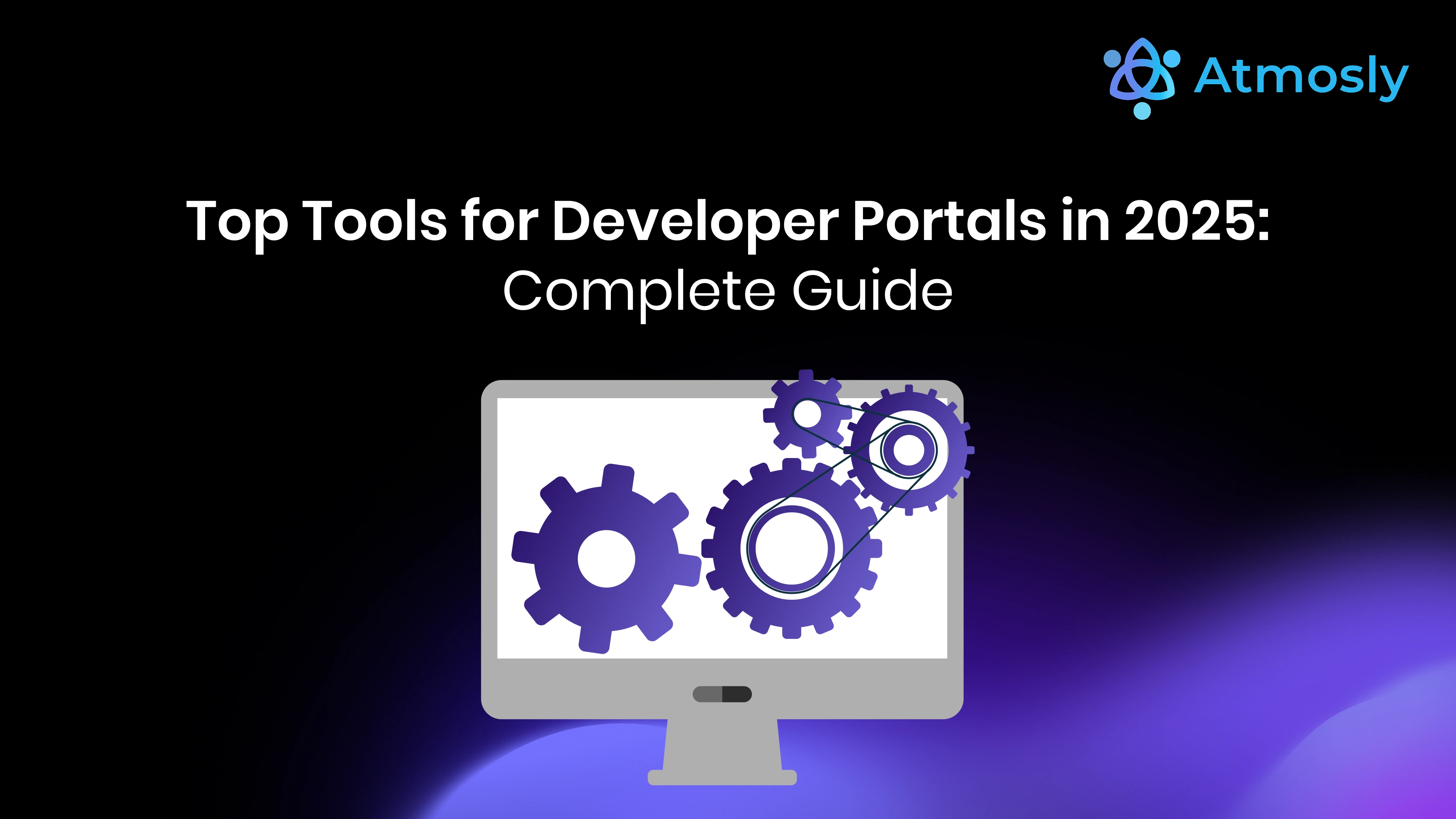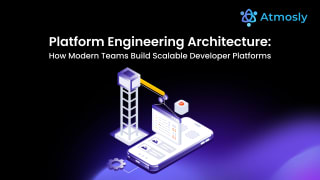1. Introduction
In the modern software ecosystem, developers face growing complexity. They manage microservices, APIs, cloud environments, Kubernetes clusters, CI/CD pipelines, and compliance frameworks. While these technologies accelerate innovation, they also create cognitive overload for developers.
This complexity has given rise to developer portals centralized platforms designed to simplify workflows, provide self-service capabilities, and improve the overall developer experience (DX). With developer portals, engineers no longer need to dig through scattered documentation, wait on operations teams, or manage infrastructure manually. Instead, they gain a single hub that brings together APIs, services, environments, and tools.
In 2025, developer portals have become mainstream, with options ranging from open-source frameworks like Backstage to commercial Internal Developer Portals (IDPs) such as Port, Cortex, Humanitec, and Atmosly. There are also specialized API developer portals like Apigee, Kong, and WSO2 for external API ecosystems.
But with so many choices, the question becomes: Which tool is right for your organization?
This guide explores the top developer portal tools in 2025, explains their features, strengths, and limitations, and helps you make an informed decision about which platform will best serve your team’s needs.
2. What Are Developer Portals?
A developer portal is a centralized platform where developers can access everything they need to build, deploy, and manage applications. It’s essentially a single pane of glass for engineering resources.
There are two main categories of developer portals:
2.1 API Developer Portals
These are external-facing portals designed for third-party developers who consume a company’s APIs. They typically include:
- API documentation and guides.
- API keys and authentication workflows.
- Usage dashboards and analytics.
- Sandboxes for testing APIs.
Examples: Apigee (Google Cloud), Kong Portal, WSO2 API Manager.
API portals are critical for companies monetizing APIs or building developer ecosystems (e.g., Stripe, Twilio).
2.2 Internal Developer Portals (IDPs)
These are internal-facing portals that empower in-house developers to:
- Discover services via a service catalog.
- Provision infrastructure through self-service workflows.
- Generate new applications using templates and pipelines.
- Access documentation (APIs, systems, runbooks) in one place.
- Monitor workloads, costs, and compliance.
Examples: Backstage, Port, Cortex, Humanitec, Atmosly.
Benefits of Developer Portals
- Faster onboarding: New developers get up to speed quickly.
- Self-service: Reduces reliance on operations teams.
- Consistency: Standardized workflows reduce errors.
- Compliance: Enforces security and governance.
- Developer happiness: Improves productivity and satisfaction.
3. Why Do Organizations Need Developer Portal Tools?
Developer portals aren’t just a “nice-to-have.” They address critical bottlenecks in software delivery.
3.1 Reducing Developer Cognitive Load
Without a portal, developers must juggle dozens of tools: Jenkins for CI/CD, Terraform for IaC, Confluence for documentation, Prometheus for monitoring. An IDP unifies these, reducing context-switching.
3.2 Accelerating Onboarding
For a new developer, setting up local environments, learning systems, and requesting access can take weeks. With a portal, they can discover services, spin up environments, and deploy code on day one.
3.3 Enabling Self-Service
Instead of filing tickets for new environments or pipelines, developers can use a portal’s UI or API to handle these tasks themselves. This frees up DevOps teams to focus on strategic projects.
3.4 Standardizing Governance
Developer portals enforce organizational standards. For example, all new microservices can be scaffolded using secure templates that include logging, monitoring, and compliance guardrails by default.
3.5 Supporting Platform Engineering
Developer portals are central to platform engineering, the practice of building internal platforms that improve developer experience. In fact, Gartner predicts that by 2027, 80% of large software engineering organizations will establish platform engineering teams, and IDPs will be at their core.
4. Key Features to Look for in Developer Portal Tools
Not all portals are created equal. The right choice depends on your organization’s needs, but these features are essential:
4.1 Service Catalog & Discovery
A searchable catalog of microservices, APIs, and resources. Developers should be able to easily find services, owners, and dependencies.
4.2 Self-Service Infrastructure
Portals should allow developers to provision environments, databases, or pipelines without relying on ops teams.
4.3 Software Templates & Pipelines
Standardized templates ensure new services follow organizational best practices. For example, creating a new microservice should automatically include CI/CD pipelines, monitoring, and security.
4.4 API Documentation & TechDocs
Centralized documentation ensures consistency and discoverability. Some portals, like Backstage, provide Markdown-based documentation systems.
4.5 Access Controls & Compliance
Built-in role-based access control (RBAC), policy enforcement, and compliance checks prevent security gaps.
4.6 Monitoring & Cost Intelligence
Developer portals should integrate with observability tools (Grafana, Prometheus) and provide cost insights, especially for Kubernetes clusters and cloud resources.
4.7 AI and Automation
Next-gen portals include AI copilots for troubleshooting, cost optimization, and even suggesting service improvements. Example: Atmosly’s AI Copilot for Kubernetes debugging.
5. Top Tools for Developer Portals in 2025
Here are the leading tools, grouped by category, with detailed breakdowns.
5.1 Open-Source Developer Portal Frameworks
Backstage (Spotify, CNCF)
- Overview: The most widely used open-source IDP, originally built by Spotify. Donated to CNCF.
- Features: Service catalog, software templates, plugin ecosystem, TechDocs.
- Strengths: Highly customizable, strong open-source community, rich plugin marketplace.
- Weaknesses: Heavy setup, requires dedicated platform team, slow time-to-value.
- Best For: Large enterprises with resources to maintain a custom platform.
KrakenD
- Overview: API gateway with developer portal features.
- Features: API aggregation, authentication, documentation.
- Strengths: Lightweight, performant.
- Weaknesses: Limited IDP features.
- Best For: API-first companies that don’t need full IDP capabilities.
5.2 Commercial Internal Developer Portals (IDPs)
Port
- Overview: A commercial IDP offering self-service and workflows.
- Features: Service catalog, workflows, governance.
- Strengths: Quick to deploy, user-friendly.
- Weaknesses: Less customizable than open-source.
- Best For: Startups and mid-sized teams.
Cortex
- Overview: Service catalog and scorecard-based governance.
- Features: Service ownership, health metrics, compliance.
- Strengths: Promotes accountability and quality.
- Weaknesses: Not focused on infra automation.
- Best For: Teams prioritizing service reliability and compliance.
Humanitec
- Overview: Environment and workload management platform.
- Features: GitOps integration, workload orchestration.
- Strengths: Strong environment control.
- Weaknesses: Limited focus on AI and developer UX.
- Best For: Enterprises with complex infrastructure.
Atmosly
- Overview: Combines IDP capabilities with DevOps automation.
- Features:
- AI Copilot for Kubernetes debugging.
- One-click environment cloning.
- Visual pipeline builder.
- Cost intelligence dashboards.
- Strengths: All-in-one platform, reduces toolchain sprawl, AI-first design.
- Weaknesses: Commercial (subscription-based).
- Best For: Startups, scaleups, and enterprises that want simplicity + automation.
5.3 API Developer Portal Solutions
Apigee (Google Cloud)
- Overview: Enterprise-grade API management and developer portal.
- Features: API publishing, analytics, monetization.
- Strengths: Comprehensive, scalable.
- Weaknesses: Expensive, complex setup.
- Best For: Large enterprises monetizing APIs.
Kong Portal
- Overview: Developer portal bundled with Kong API Gateway.
- Features: API documentation, plugins, authentication.
- Strengths: Scales with Kong ecosystem.
- Weaknesses: Primarily API-focused.
- Best For: API-first teams already using Kong.
WSO2 API Manager
- Overview: API management with developer portal.
- Features: Full API lifecycle, governance, documentation.
- Strengths: Robust features, enterprise support.
- Weaknesses: Requires maintenance.
- Best For: Enterprises needing strong API governance.
6. Benefits of Using Developer Portal Tools
Developer portals create measurable business value:
- Improved Developer Experience: Less time spent searching or requesting support.
- Faster Onboarding: New hires become productive within hours.
- Self-Service Efficiency: Developers handle deployments and infra independently.
- Standardization: Ensures services meet organizational best practices.
- Security & Compliance: Guardrails built into workflows.
- Cost Optimization: Portals with monitoring (like Atmosly) reduce cloud waste.
- Innovation: Freed from operational toil, developers focus on building products.
7. Challenges of Developer Portals
Despite their benefits, developer portals present challenges:
- Setup Complexity: Open-source tools like Backstage require months of effort.
- Toolchain Sprawl: Integrating multiple tools increases overhead.
- Customization vs Managed Trade-Off: Flexibility vs simplicity.
- Vendor Lock-In: Risk with commercial IDPs.
- Cultural Adoption: Teams must shift to self-service mindsets.
Mitigation Strategies
- Start small with a pilot project.
- Choose integrated platforms to reduce sprawl.
- Train teams in portal usage.
- Balance open-source flexibility with managed simplicity.
8. Future of Developer Portal Tools
The next generation of developer portals will include:
- AI-Powered Automation – AI copilots for debugging, scaling, and cost optimization.
- Shift to Developer Experience Platforms (DXPs) – Expanding beyond IDPs into full DXPs.
- Policy-as-Code & Compliance Automation – Embedding governance directly.
- GitOps-Native Workflows – Declarative automation across environments.
- Unified Platforms – Consolidating toolchains into fewer platforms (e.g., Atmosly).
In short, the future of developer portals is smarter, more integrated, and developer-first.
9. Conclusion
Developer portals are no longer optional, they are the backbone of modern software delivery. From open-source frameworks like Backstage, to commercial IDPs like Port, Cortex, and Humanitec, to integrated platforms like Atmosly, organizations have a wide range of tools to choose from.
The right tool depends on your context:
- Backstage offers flexibility but requires investment.
- Commercial IDPs deliver faster time-to-value.
- Atmosly goes further by combining IDP with DevOps automation, AI copilots, and cost intelligence.
In 2025, the smartest choice is not just adopting a portal, it’s choosing the platform that simplifies complexity and accelerates innovation.






